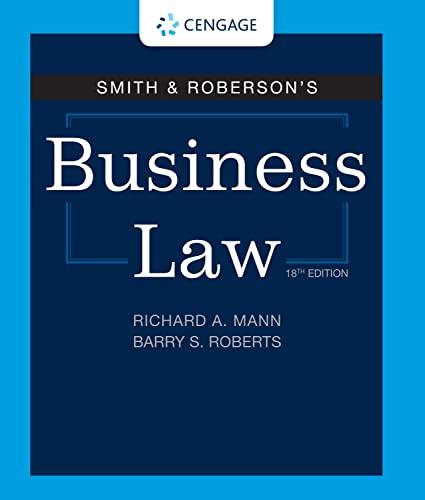Question
Question 1- Smith was in the market for a new car. He found what he was looking for at John's Auto Dealership. Smith offered to
Question 1-
Smith was in the market for a new car. He found what he was looking for at John's Auto Dealership. Smith offered to buy the car for $20,000, subject to being able to arrange a $10,000 loan at his bank. John agreed. Smith visited his bank, and discussed the matter with his financial counsellor, Susan. Susan said she would have to secure approval from regional office, but was confident that the loan would be approved within two days. Smith went back to John's and said he was getting the bank loan and would be taking the car. They shook hands. Smith agreed to return in two days with the $20,000 and John agreed to have the car ready for him when he returned. On the following day, Susan phoned Smith and told him that the loan had been approved, but for only $5,000. As a result, Smith was unable to pay the $20,000 and John sued him for breach of contract.
Smith sued Susan and the bank, saying that they were to blame for his breach of the contract to buy the car.
Does Smith have any cause of action against Susan or the bank? Explain, showing analysis of the legal principles involved.
Question 2:
A bank customer asked the branch manager to request authorization to increase the amount of his loan from $30,000 to $40,000. The branch manager made the request but his superiors refused to allow the increase. They also instructed him to reduce the amount of the loan by $5,000 within three weeks. The branch manager then informed the customer that a second customer (a mortgage company) might lend him $30,000 for 90 days at 2%/month. The customer gave the branch manager authority to approach the mortgage company and give it any information on him they required. The branch manager talked to the mortgage company and told it the customer's story, including the fact that he had reached the limit of his credit with the bank. He did not report the bank's rejection of the application for an increase, nor the requirement that his bank loan be reduced by $5,000. The mortgage company agreed to make the loan to the customer, and the funds were deposited to the customer's account at the bank, wiping out his large overdraft and reducing his loan from $30,000 to $19,000. Fifteen months later the customer was put into receivership by the bank. The mortgage company was not repaid and sued the branch manager and the bank for negligence.
Should the mortgage company's action succeed? Show your legal analysis.
Step by Step Solution
There are 3 Steps involved in it
Step: 1

Get Instant Access to Expert-Tailored Solutions
See step-by-step solutions with expert insights and AI powered tools for academic success
Step: 2

Step: 3

Ace Your Homework with AI
Get the answers you need in no time with our AI-driven, step-by-step assistance
Get Started


